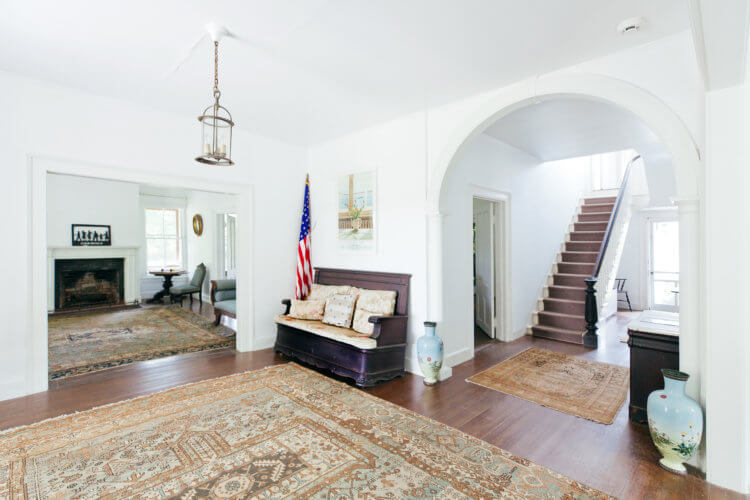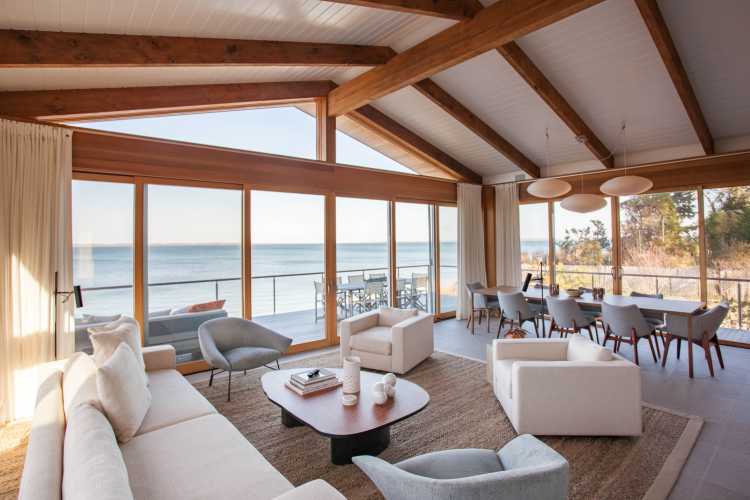A symbol of East Hampton’s famed summer colony, a former boarding house in East Hampton Village is looking for a buyer — a family who will love it as much as the current owners’ family has for the last 100 years, according to Frank Newbold of Sotheby’s International Realty. The four-acre property at 72 Apaquogue Road is now asking $14.9 million.
Along with Marilyn Clark, Newbold is representing the listing, a house originally built in 1884 that sits in one of the most desirable areas on the South Fork. It is “a unique opportunity,” Newbold says, “to acquire a very special property.”
While the home is seen as a symbol of old East Hampton, Newbold says it can be modified. “Historically, it’s not protected in any way.” Only the timber frame houses and homes in the historic district are protected from demolition. “This part of the village is not.”
Located just minutes from Georgica Beach, it is the largest village estate lot available so close to the ocean. The property provides major potential for prospective buyers looking to create their own retreat. Zoning allows for a substantial home — to the tune of 10,550 square feet, plus a finished basement. Even with a home of that size, there will be plenty of room for a pool and tennis court.
With its front facade facing Apaquogue Road, prospective buyers interested in restoring the house have asked about picking it up and moving it to the center of the property, which could be done. Though there are two separate entrances to the property, one on Apaquogue Road and one on LaForest Road, one move that cannot happen is a subdivision as it is located in a four-acre zoning.
But, the home does carry a rich history. According to “Images of America: East Hampton,” the house stands on the site of the first boarding house in the East Hampton summer colony, operated by Abraham D. Candy, a teacher at the Clinton Academy (now a museum). Candy also owned a 107-acre farm and began renting to boarders in the early 1840s.
The farm changed hands in 1882 when Mrs. E. A. Laforest of New York purchased it, though it was destroyed that winter in a fire. A new boarding house, called the Apaquogue, was built there two years later. In 1895, The East Hampton Star reported, “The spot upon which the Apaquogue is located is famous as a summer boarding place,” noting that it overlooked the ocean on the south side. “The location for the house is such that most delightful marine and landscape views can be had from each room.”
The boarding house was built just as the railroad first arrived in East Hampton when New York City residents were looking to escape the heat and go to the beach, where it was 10 degrees cooler, Newbold says. “People would come in and really check in for the entire summer.”
The home has become a symbol of the original summer colony, he says. “It is a kind of a landmark as you’re coming and going to Georgica Beach.”
Standing taller than most, it is four stories high, the only four-story home in East Hampton Village, Newbold believes (We can think of no other either). It holds 16 bedrooms and seven bathrooms. The upper story rooms still have numbers on the doors.
“When it was originally built as a boarding house it was the closest to the ocean,” Newbold says. There are still ocean views from the upper floors. The shingled house features a wide large wrap-around porch for enjoying the ocean breezes on summer nights. Even while mansions were built around it, the breeze never changed.
There are high ceilings on all of the floors and original period details remain, such as the original transoms over the doors. The doors could be shut for privacy, but the transoms would be left open to allow the ocean breezes in, Newbold explains.
The original “bell call” is in tact. “Someone never went because it still says parlor,” the agent says with a laugh.
The home has the original layout and even features a bike storage room. “It harkens back to do a different, slower period of time,” he says. The biggest room in the house is the dining room because when there were boarders, they would eat breakfast, lunch and dinner there, he continues.
The property was sold in 1912 to Mrs. A. A. Cater of New York, who had plans to convert the building into a summer residence. But, before that occurred, it was sold again, eventually ending up in the hands of Julian S. Myrick, president of the Maidstone Club, in 1919. His descendants still own it today.
They put it on the market for the first time in 100 years in 2019, listing it for $16.9 million. It was briefly removed and then reintroduced during the summer of 2020 with a $2 million price reduction.
“They want to find the right person who will love it as much as their family did so we reduced it to just under $15 million, in acknowledgment of the work that has to be done” to make it a home for a modern family, Newbold says.
[Listing: 72 Apaquogue Road, East Hampton | Brokers: Frank E. Newbold and Marilyn Clark, Sotheby’s International Realty] GMAP
Email tvecsey@danspapers.com with further comments, questions or tips. Follow Behind The Hedges on Twitter, Instagram and Facebook.



































